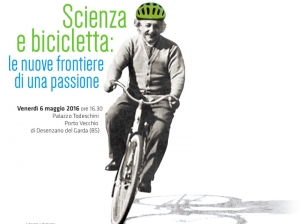
Manifesto del convegno di Desenzano dove è stata inaugurata la rete italiana di Scienziati per la Bicicletta.
L’Organizzazione mondiale della sanità ha aggiornato il data-base della qualità dell’aria nelle grandi città. Adesso sono 3.000 in 103 paesi; tra il 2008 e il 2013 la qualità è peggiorata dell’8% nonostante l’aumento dei provvedimenti per limitare l’inquinamento.
***
Su Nature Physics – e gratis su arXiv – il gruppo coordinato da Marco Fattori descrive un entanglement non fra due particelle o atomi ma di un gas ultra-freddo tra due “pozzetti” simmetrici di un oscillatore armonico (va di moda in questo periodo!):
At a critical value of the interaction strength, we observe a continuous quantum phase transition where the gas spontaneously localizes in one well or the other, thus breaking the underlying symmetry of the system.
*
Su Nature tout court, frotte di genetisti di cui parecchi del CNR, trovano una correlazione robusta tra 74 SNP (polimorfismo di un singolo nucleotide) su 9.000 mila, e gli anni di studio completati, nel genoma di 293.723 europei in quello di 111.349 britannici che fanno da gruppo di controllo. Le varianti sono quasi tutte nelle regioni del genoma che regolano lo sviluppo cerebrale del feto.
Trovano anche correlazioni
con un aumento delle prestazioni cognitive e del volume intracranico, con un aumento del rischio di disturbo bipolare e con una diminuzione del rischio di Alzheimer e di nevrosi
come dice Ginevra Biino, nel com. stampa del CNR.
Quando era uscita la prima parte su Science, tre anni fa, ero un po’ scettica. Magari ho un bias anti-determinista, però mi sembra che nei GWAS (genome-wide association studies) si trovino sempre delle correlazioni statisticamente significative. Resta da dimostrare che 74 SNP hanno un’influenza “significativa” sul livello di studio o sulle prestazioni cognitive, quando gli autori stessi la stimano attorno allo 0,43% del contributo genetico totale e spiegherebbe il 3,2% di differenza tra portatori di quei SNP o meno.
Erika Check Hayden raccoglie pareri favorevoli e critici sull’applicazione dei GWAS alle scienze sociali.
*
IIT e HT, cont.
Alison Abbott riassume la “rissa” sullo Human Technopole, ed Ernesto Carafoli e Cesare Montecucco scrivono
We wish to highlight the stark contrast between the hardship in Italy’s publicly funded research community (see G. Parisi Nature 530, 33; 2016) and the reportedly largely unused sums of money allocated to a single research institute over the past 12 years.
After 3 years without any financial provision for bottom-up research, Italy’s government is providing €31 million (US$36 million) a year for the next 3 years to cover research in the humanities as well as science. Of this year’s 4,431 grant applications for this modest sum, just 300–500 will be successful.
By contrast, the government plans to inject €150 million a year for the next 10 years into the Human Technopole project, which will focus on genomics, big data, ageing and nutrition. The recipient is the Italian Institute of Technology in Genoa, which is self-governing and so not publicly accountable — despite the large sums of public money involved. A recent report indicates that half of the institute’s funds remained unspent in 2010–14 (see go.nature.com/vouywf; in Italian).
The government should establish an adequately funded agency that has transparent jurisdiction over the funding and execution of research. The agency would also monitor the progress of the Human Technopole and oversee its accountability.